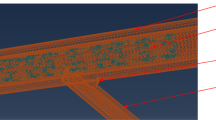Abstract
When atherosclerotic lesions are found within a coronary bifurcation, a double stent implantation is sometimes required to treat the disease of each branch. The clinical procedure can result in the positioning of several stents in the bifurcation. In the study, physiological flows in typical configurations of such stented coronary bifurcations were numerically modelled using the finite volumes method. Two deployed Palmaz stents were inserted in a 90° coronary bifurcation, simulating a double stent implantation. As the geometric position of the metallic stent cells can vary, several models of broken cells were proposed and compared to characterise the influence of the stent struts protruding into the collateral branch. Flow features in the bifurcation surroundings changed from one model to another. These changes could lead to the occurrence of flow stasis and also of recirculation areas downstream from the struts, depending on the way the strut was opened. The stent struts protruding into the lumen of the collateral branch induced high values of shear stress at the stent wall of about 20 Nm−2, which could stimulate platelet activation. In addition, these areas of high shear stress values were concomitant with areas of low shear stress values of about 0.5 Nm−2. These regions could be prone to platelet adhesion and so to thrombo-embolic complications. The analysis of the flow field indicated that it would be judicious to use dedicated bifurcated stents to treat bifurcation lesions.
Similar content being viewed by others
References
Berne, R. M., andLevy, M. N. (1967): ‘Cardiovascular physiology’ (Mosby, St. Louis, MO, 1967), p. 201
Berry, J. L., Moore, J. E., Newman, V. S., andRouth, W. D. (1997): ‘In vitro flow visualizations in stented arterial segments’,J. Vasc. Invest.,3, pp. 63–68
Bertolotti, C., Deplano, V., Fuseri, J., andDupouy, P. (2001): ‘Numerical and experimental models of post-operative realistic flows in a stenosed coronary bypasses’,J. Biomech.,34, pp. 1049–1064
Bluestein, D., Li, Y. M., andKrukenkamp, I. B. (2002): ‘Free emboli formation in the wake of bi-leaflet mechanical heart valves and the effects of implantation techniques’,J. Biomech.,35, pp. 1533–1540
Brueck, M., Scheinert, D., Flashskampf, F. A., Danie, W. G., andLudwig, J. (2002): ‘Sequential vs. Kissing balloon angioplastry for stenting of bifurcation coronary lesions’,Catheter. Cardiovasc. Interv.,55, pp. 461–466
Dumoulin, C., andCochelin, B. (2000): ‘Mechanical behaviour modelling of balloon-expandable stents’,J. Biomech.,33, pp. 1461–1470
Fabregues, S., Baijens, K., Rieu, R., andBergeron, P. (1997): ‘Hemodynamics of endovascular prosthese’,J. Biomech.,31, pp. 45–54
Frank, A. O., Walsh, P. W., andMoore, J. E. (2002): ‘Computational fluid dynamics and stent design’.Artif. Organs,26, pp. 614–621
Fukushima, T., andAzuma, T. (1982): ‘The horseshoe vortex: a secondary flow generated in arteries with stenosis, bifurcation and branchings’,Biorheology,19, pp. 143–154
He, X., andKu, D. N. (1995): ‘Flow in T-bifurcations: effect of the sharpness of the flow divider’,Biorheology,32, pp. 447–458
Henry, F. S. (2000): ‘Flow in stented arteries. Intra and extracorporeal cardiovascular fluid dynamics’,Verdonk, P., andPerktold, K. (Eds): (WIT Press, Southampton, 2000), pp. 333–364
Hoffmann, R., andMintz, G. S. (2000): ‘Coronary in-stent restenosis-predictors, treatment and prevention’Eur. Heart J.,21, pp. 1739–1749
Lefevre, T., Louvard, Y., Morice, M. C., Dumas, P., Loubeyre, C., Benslimane, A., Premchand, R. K., Guillard, N., andPiechaud, J. F. (2000): ‘Stenting of bifurcation lesions: classification, treatments, and results’,Catheter. Cardiovasc. Interv.,49, pp. 274–283
Lefevre, T., Louvard, Y., Morice, M. C., Loubeyre, C., Piechaud, J. F., andDumas, P. J. (2001): ‘Stenting of bifurcations lesions: a rational approach’,J. Interv. Cardiol.,14, pp. 573–585
Leon, M. B., andBakhai, A. (2003): ‘Drug-eluting stents and glycoprotein lib/IIIa inhibitors: Combination therapy for the future’,Am. Heart J.,146, pp. S13-S17
Migliavacca, F., Petrini, L., Colombo, M., Auricchio, F., andPietrabissa, R. (2002): ‘Mechanical behavior of coronary stents investigated through the finite element method’,J. Biomech.,35, pp. 803–811
Moake, J. L., Turner, N. A., Statopoulos, N. A., Nolasco, L., andHellums, J. D. (1988): ‘Shear-induced platelet aggregation can be mediated by vWF released from platelets, as well as by exogenous large or unusually large vWF multimers, requires adenosine diphosphate and is resitant to aspirin’,Blood,71, pp. 1366–1374
Moore, J. E., andBerry, J. L. (2002): ‘Fluid and solid implications of vascular stenting’,Ann. Biomed. Eng.,30, pp. 498–508
Morris, L., Delassus, P., Walsh, M., andMcGloughlin, T. (2004): ‘A mathematical model to predict thein vivo pulsatile drag forces acting on bifurcated stent grafts used in endovascular treatment of abdominal aortic aneuryms (AAA)’,J. Biomech., (in press)
Natarajan, S., andMokhtarzadeh-Dehghan, M. R. (2000): ‘A numerical and experimental study of periodic flow in a model of corrugated vessel with application to stented arteries’,Med. Eng. Phys.,22, pp. 555–566
Peacock, J., Hankins, S., Jones, T., andLutz, R. (1995): ‘Flow instabilities induced by coronary artery stents: assessment with anin vitro pulse duplicator’,J. Biomech.,28, pp. 17–26
Perktold, K., Hofer, M., Rappitsch, G., Loew, M., Kuban, B. D., andFriedman, M. H. (1997): ‘Validated computation of physiologic flow in a realistic coronary artery branch’,J. Biomech.,31, pp. 217–228
Spijker, H. T., Graaff, R., Boonstra, P. W., Busscher, H. J., andvan Oeveren, W. (2003): ‘On the influence of flow conditions and wettability on blood material interactions’.Biomaterials,24, pp. 4717–4727
Stanek, B., Liepsch, D., andPflugbeil, G. (1998): ‘Flow studies of stents in models of the carotid artery’. 3rd World Congress of Biomechanics, p. 208a
Wentzel, J. J., Krams, R., Schuurbiers, J. C. H., Oomen, J. A., Kloet, J., Van der Giessen, W. J., Serruys, P. W., andSlager, C. J. (2001): ‘Relationship between neointimal thickness and shear stress after Wallstent implantation in human coronary arteries’,Circulation,103, pp. 1740–1745
Yamashita, T., Nishida, T., Adamian, M. G., Briguori, C., Vaghetti, M., Corvaja, N., Albiero, R., Finci, L., Di Mario, C., Tobis, J. M., andColombo, A. (2000): ‘Bifurcation lesions: two stents versus one stent-immediate and follow-up results’,J. Am. Coll. Cardiol.,35, pp. 1145–1151
Author information
Authors and Affiliations
Corresponding author
Rights and permissions
About this article
Cite this article
Deplano, V., Bertolotti, C. & Barragan, P. Three-dimensional numerical simulations of physiological flows in a stented coronary bifurcation. Med. Biol. Eng. Comput. 42, 650–659 (2004). https://doi.org/10.1007/BF02347547
Received:
Accepted:
Issue Date:
DOI: https://doi.org/10.1007/BF02347547




